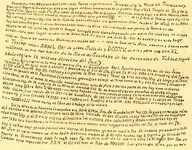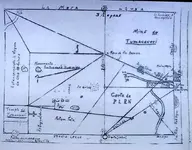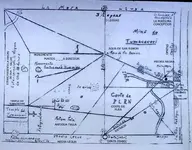gollum
Gold Member
- Joined
- Jan 2, 2006
- Messages
- 6,770
- Reaction score
- 7,734
- Golden Thread
- 0
- Location
- Arizona Vagrant
- Detector(s) used
- Minelab SD2200D (Modded)/ Whites GMT 24k / Fisher FX-3 / Fisher Gold Bug II / Fisher Gemini / Schiebel MIMID / Falcon MD-20
- Primary Interest:
- All Treasure Hunting
- #1
Thread Owner
OK, here's something for you experts to scratch your collective heads over! 

There is a well known string of Spanish Missions just North of Nogales, Arizona. One of those missions is named Tumacacori. There were several mines associated with it. The location of the current Tumacacori Mission is not where the original was.
In researching another possible location, I came across a reference to a document. Long story short, there was a Nun in Seville at the Spanish Archives. She came across a document with a possible date of 1658. I have provided a copy of the document, an exact transcription of the document, and an exact translation of the document, and an analysis of the document (by the NPS) giving specifics as to why they believe it is a fake.
The reason I'm doing this is because the National Park Service states that the document is a fake. One person, at least, believes the document is authentic. So much so, that he has spent about $90,000.00 and 19 years of his life following this documents' directions. He has hired heavy equipment and actually found two tunnels at the site. He believes he knows the location of the third, where the motherlode is buried.
If it is a fake (and that is very possible), I have seen and heard of people doing this with old maps having to do with The Lost Dutchman's Mine. Spend their entire lives following their map, and die poor, knowing they were just about to find it every day, for 50 years.
Since there are a few people in this forum with more some experience in Colonial Spanish Documents, Castillan Language Speech, and Writing, I figured we could figure this thing out.
Thanks-Mike


There is a well known string of Spanish Missions just North of Nogales, Arizona. One of those missions is named Tumacacori. There were several mines associated with it. The location of the current Tumacacori Mission is not where the original was.
In researching another possible location, I came across a reference to a document. Long story short, there was a Nun in Seville at the Spanish Archives. She came across a document with a possible date of 1658. I have provided a copy of the document, an exact transcription of the document, and an exact translation of the document, and an analysis of the document (by the NPS) giving specifics as to why they believe it is a fake.
The reason I'm doing this is because the National Park Service states that the document is a fake. One person, at least, believes the document is authentic. So much so, that he has spent about $90,000.00 and 19 years of his life following this documents' directions. He has hired heavy equipment and actually found two tunnels at the site. He believes he knows the location of the third, where the motherlode is buried.
If it is a fake (and that is very possible), I have seen and heard of people doing this with old maps having to do with The Lost Dutchman's Mine. Spend their entire lives following their map, and die poor, knowing they were just about to find it every day, for 50 years.
Since there are a few people in this forum with more some experience in Colonial Spanish Documents, Castillan Language Speech, and Writing, I figured we could figure this thing out.
Thanks-Mike








